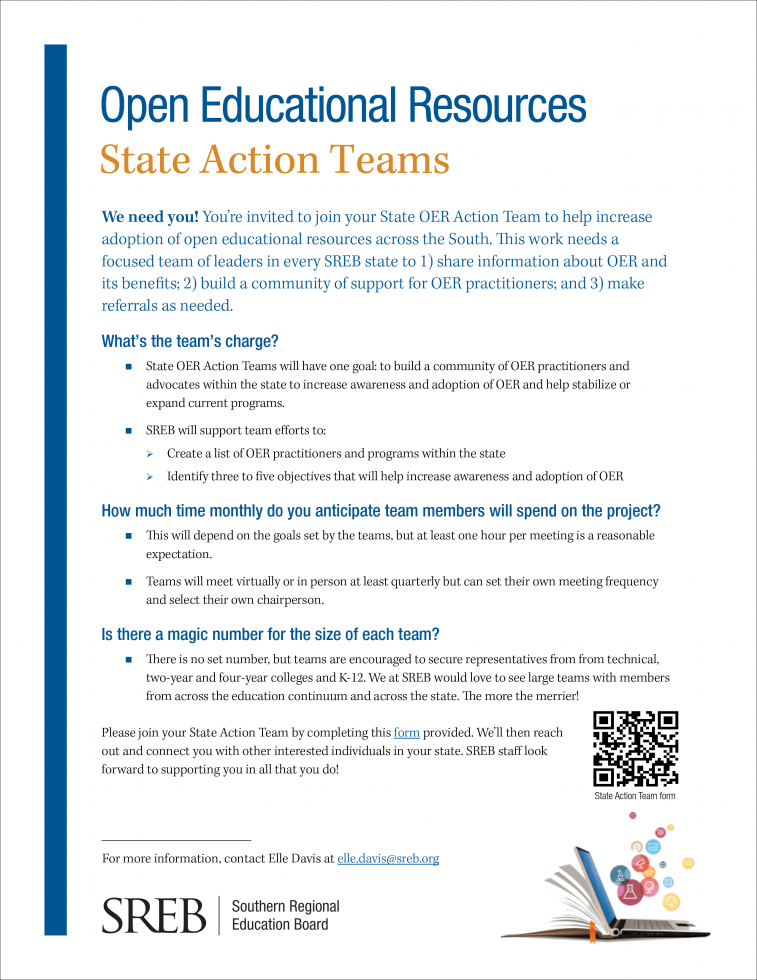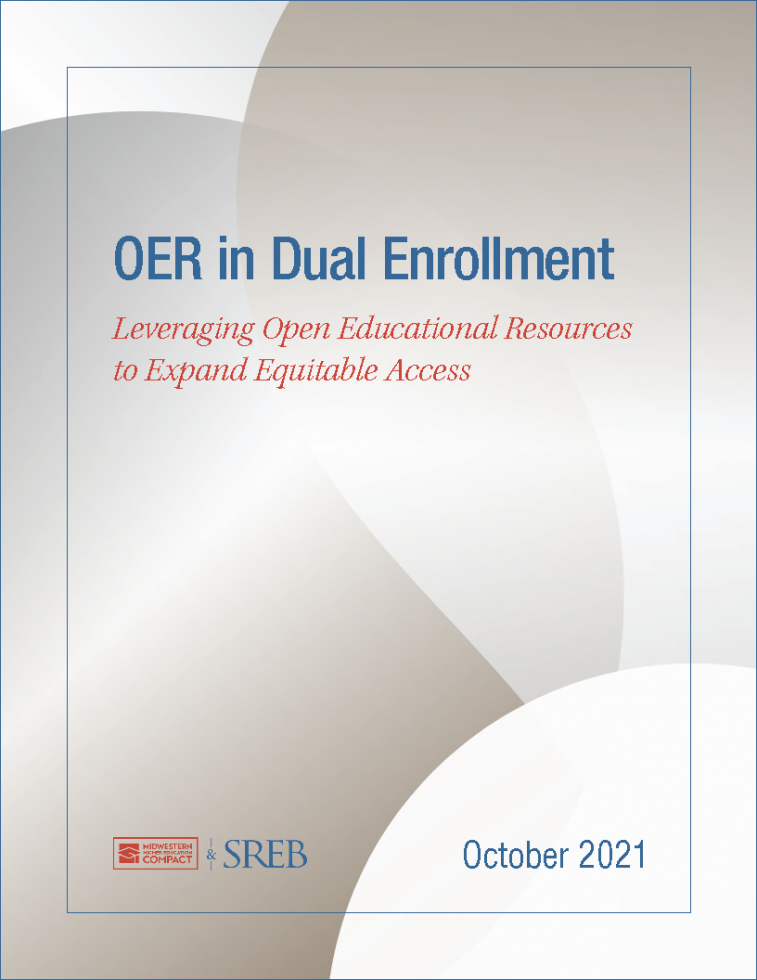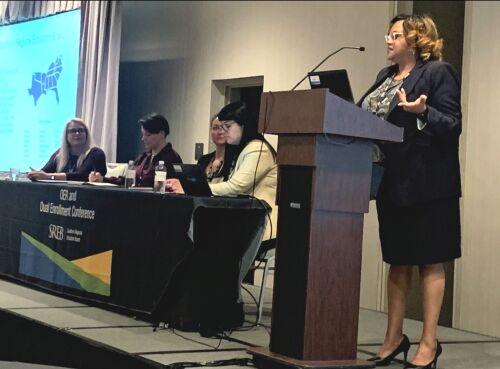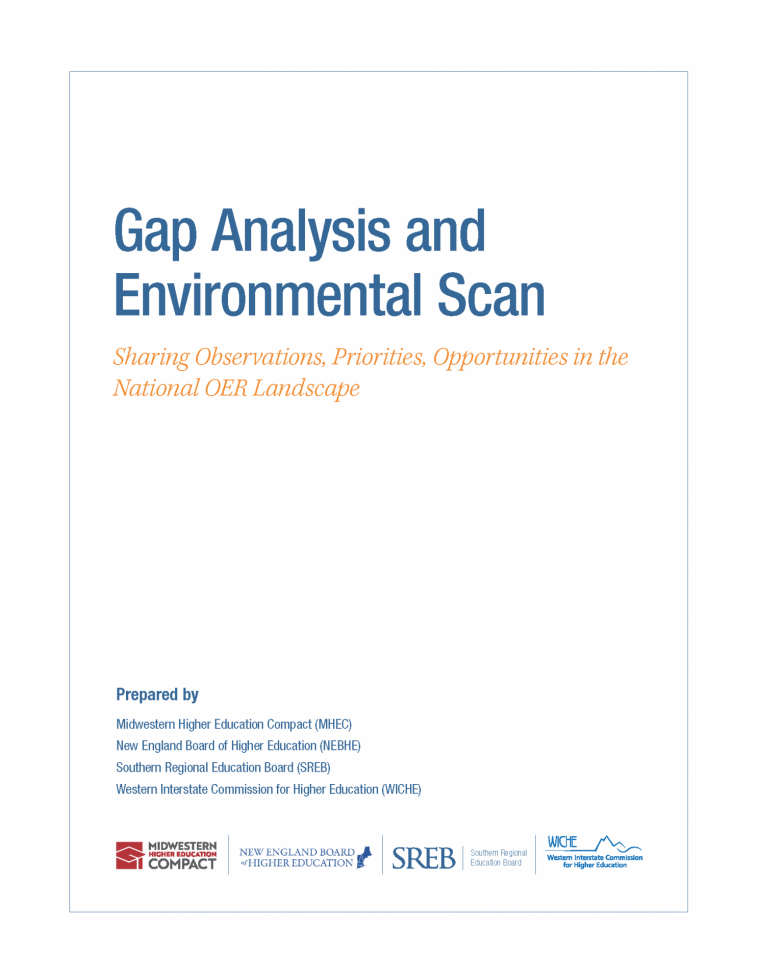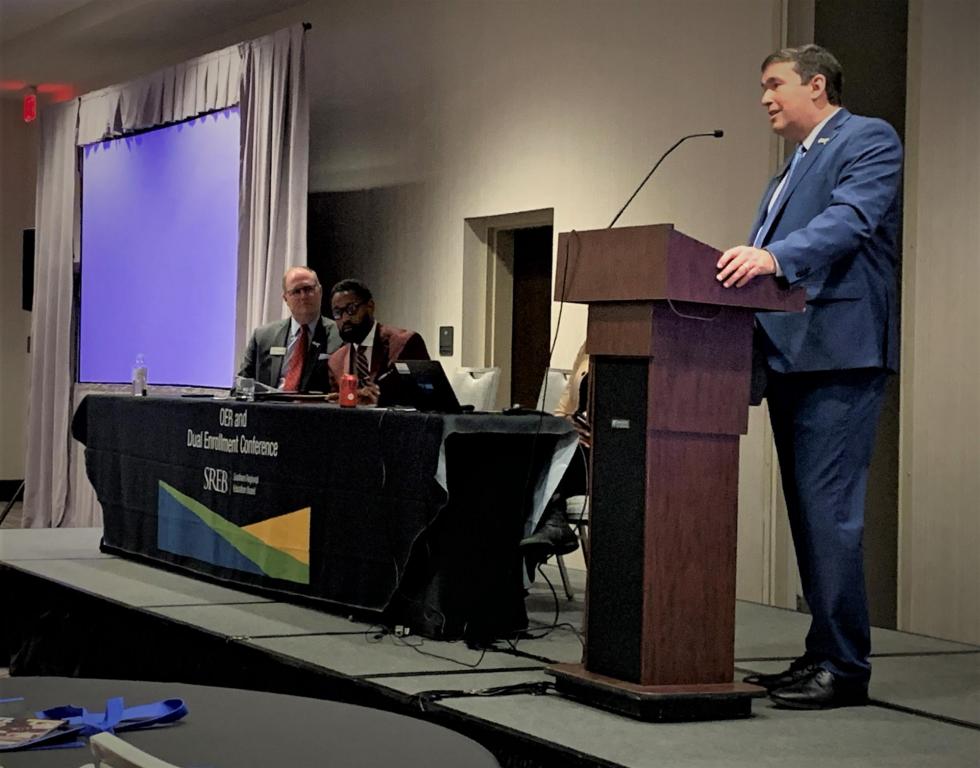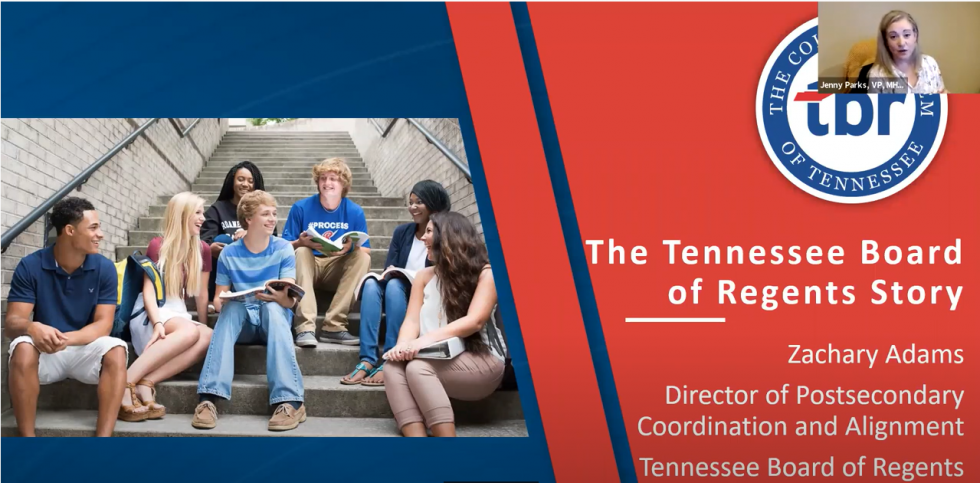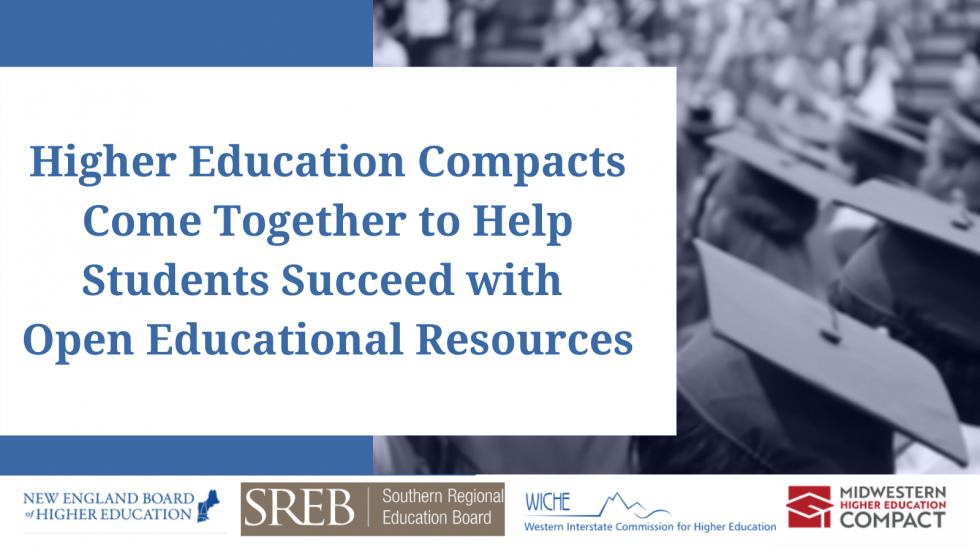Topic: Open Educational Resources
Open Educational Resources
Open educational resources are high quality teaching, learning and research materials that are freely accessible to all. Using OER in K-12 and postsecondary education creates more accessible and equitable educational opportunities. Open licensing allows educators, students and institutions to customize and share resources ─ from a single lesson plan to entire textbooks ─ without cost or copyright restrictions.
Open Educational Resources in Higher Education
A State- and System-level Analysis
 This report analyzes state- and
system-level policies on open educational resources in the United
States. It highlights policy that supports the adoption and
growth of OER and offers recommendations for promising policies
to scale open education. The report was published by a
collaboration among the four regional education compacts, the
National Consortium for Open Educational Resources.
This report analyzes state- and
system-level policies on open educational resources in the United
States. It highlights policy that supports the adoption and
growth of OER and offers recommendations for promising policies
to scale open education. The report was published by a
collaboration among the four regional education compacts, the
National Consortium for Open Educational Resources.
Download the PDF
Wiring the Future
Building an Infrastructure for Open Education
The open education movement has propelled open educational resources to the forefront of conversations on improving access and success in higher education. Technological advancements have expanded educational opportunities by allowing students to access information instantly, communicate globally and share learning materials at little to no cost.
Explore Publishing Possibilities with Manifold
OER Summer Webinar Series
View webinar recording
When it comes to publishing open educational resources, it may be difficult to know exactly where to start. Publishing with Manifold is simple. Manifold is a collaboration between the CUNY Graduate Center, the University of Minnesota Press and Cast Iron Coding. Publications can be books, but they don’t have to be.
Adapting to Innovation: Are you ready for AI?
OER Summer Webinar Series
View webinar recording
As technological advancements develop rapidly, educators are faced with challenges for how to strategically approach adapting to innovation. Join the Texas Higher Education Coordinating Board Division of Digital Learning in a lively discussion about how to strategically engage with evolving technologies, like AI, that will significantly impact how we teach, learn, do business and live.
Open & Affordable Education @ GSU Library
OER Summer Webinar Series
View webinar recording
Attendees joined our informative webinar on open educational resources at Georgia State University. We explored the benefits and implementation of OER, highlighted how these resources can enhance teaching and learning while reducing costs for students.
SREB and Ahrash Bissell from the NROC Project
OER Summer Webinar Series
View webinar recording
Learn more about the National Readiness Organization focused on College and Career Project. As a leader in open educational resources, the NROC Project offers EdReady, an adaptive learning platform to personalize math and English instruction. If you are searching for ways to meet the needs of every student, get ideas in this webinar.
State Action Teams
Open Educational Resources
Join your State OER Action team to help increase adoption of OER across the Southern region.
Arkansas Community Colleges to benefit from joining Open Education Network
The Arkansas Community Colleges system is joining the Open Education Network, advancing the use of open educational resources (OER) across the state.
Faculty and administrators at Arkansas’ 22 community and technical colleges now can tap the network’s training and support for offering free, high-quality classroom resources to students — eliminating students’ textbook costs in some courses.
OER in Dual Enrollment
Leveraging Open Educational Resources to Expand Equitable Access
The number of high schools offering dual enrollment or concurrent enrollment courses has grown significantly over the past decade. However, gaps in student access and participation persist. This report from SREB and the Midwestern Higher Education Compact examines how the use of open educational resources, or OER, can make dual enrollment courses more cost-effective and increase college access for more students. The report provides an overview of policies across 50 states and recommendations on OER adoption and usage.
Momentum grows for open educational resources
After first-ever conference, leaders can tap additional workshops on using OER to support students
SREB continues to build momentum from the first conference of its kind — the Open Educational Resources and Dual Enrollment Conference: Making a Case for Student Success, held in Atlanta in late February — by embarking on more ways to bring education leaders together around this topic.
Gap Analysis and Environmental Scan
Sharing Observations, Priorities, Opportunities in the National OER Landscape
The four regional education compacts—the Midwestern Higher Education Compact, the New England Board of Higher Education, the Southern Regional Education Board, and the Western Interstate Commission for Higher Education—are working together to help scale the adoption and use of open education resources nationally to allow millions students access to free, high-quality learning resources.
New tools may help more students succeed in college, dual enrollment courses
States are considering how they can help more students finish college — in an economy that demands higher levels of education and career preparation than ever before.
At SREB’s first conference of its kind, leaders from states, higher education, and K-12 education agencies convened in Atlanta Feb. 24-25.
The main topic was how OER — open educational resources, including high-quality, free textbooks and course materials — and stronger dual enrollment programs could help more students take college and career courses starting in high school.
HOW OPEN EDUCATIONAL RESOURCES CAN HELP MORE STUDENTS TAKE DUAL ENROLLMENT
Expensive textbooks and other classroom materials can keep students from taking dual enrollment courses if those costs aren’t covered.
The result: A lack of opportunity for many students to get a head start on college.
States, colleges and universities are making headway on this challenge. Some of the pacesetters shared their insights in a webinar led by SREB and the Midwestern Higher Education Compact in October 2021.
Why Open Educational Resources matter in the future of education
A Q&A with SREB’s Charlotte Dailey
Charlotte Dailey joined SREB in 2021 to lead our work on open educational resources. We spoke with Charlotte about why OER matter and why she works in this field.
For those who don’t know, what are open educational resources and why do they matter to the future of education?
Open educational resources are materials that can be accessed freely. They are openly licensed and available to be reused, remixed, revised, retained or redistributed. Materials that are truly OER have few to no restrictions for use in learning.
OER in Dual Enrollment
Leveraging Open Educational Resources to Expand Equitable Access
View the webinar recording
Join SREB and the Midwestern Higher Education Compact to learn the findings and recommendations of this forthcoming report.
Open educational resources, or OER, are free, openly licensed, high-quality classroom materials. Expanding their use in dual enrollment courses can help more students afford and succeed in college courses while they are still in high school.
Open Educational Resources in Dual Enrollment Webinar Series
On-Demand Recordings Available
This three-part webinar series explored how using open educational resources in dual enrollment can increase access to postsecondary education for more students.
Sessions covered:
Equitable Access and College Affordability
The Cost of OER and Return on Investment
Making a Case for Student Success: OER in Dual Enrollment and CTE
Higher Ed Compacts Come Together to Help Students Succeed with Open Educational Resources
State leaders, postsecondary education institutions and education leaders are working across state lines to promote the adoption of open educational resources (known as OER) to help millions of students access high quality learning materials that are free to use, customize and share. OER are free for students, and they make it easy for faculty to personalize lessons and textbooks to engage students with fresh, relevant content.
Open Education Resources Can Reduce Cost, Improve Quality
Collaborating to Scale Digital Learning Materials
K-12, college and university leaders are working across state lines to reduce barriers faced by students and to empower faculty with access to a wide range of instructional materials.
OER in Dual and Concurrent Enrollment Programs
Current Practice and Best Practice
View the webinar recording
This webinar presented early findings from a current study funded by the Midwestern Higher Education Compact and the Southern Regional Education Board to examine the current use of open educational resources in dual and concurrent enrollment courses. The webinar also explored best practices and lessons learned from states and dual enrollment partnerships pioneering these efforts.
GA Online Courses for Students, Teachers Available in All States
OER Courses Grades 6 -12 and Training for Teachers on Remote Learning
Available in All States
Georgia’s OER Online Courses, Grades 6 -12, and Free Training for Teachers on Remote Learning
Georgia Virtual’s OER (open educational resource) digital course content for middle grade and high school students and training courses for teachers are freely available to educators in all states thanks to the Georgia Department of Education and its Georgia Virtual Learning program.







